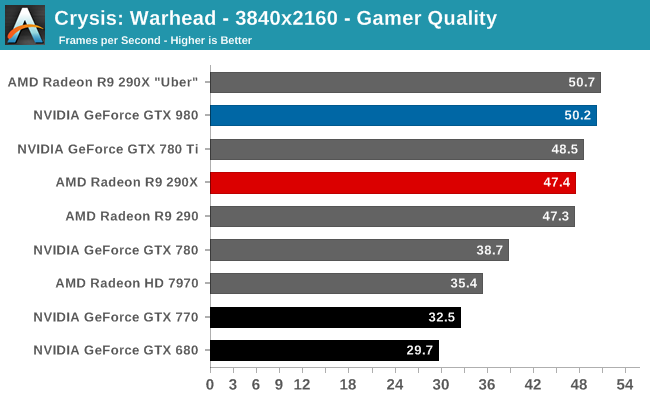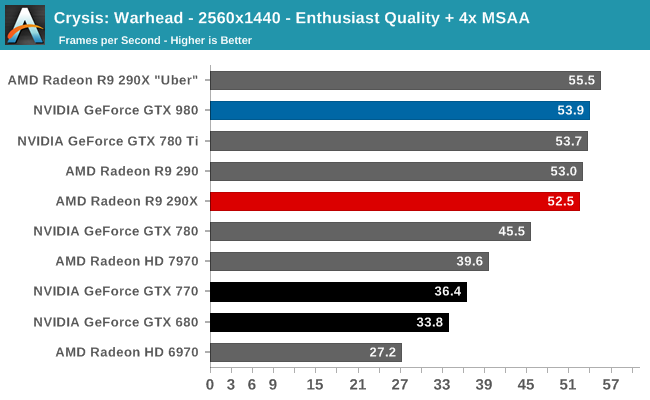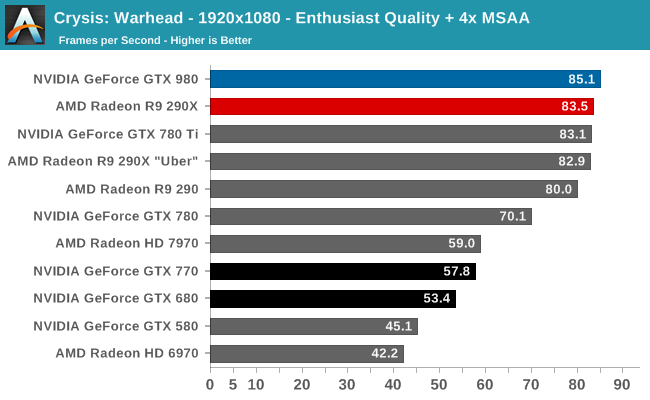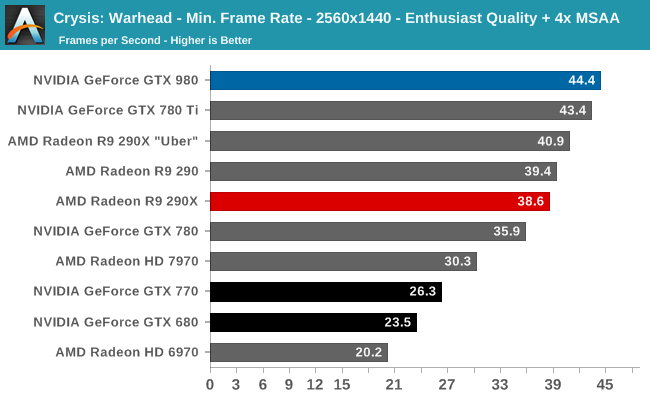The NVIDIA GeForce GTX 980 Review: Maxwell Mark 2
by Ryan Smith on September 18, 2014 10:30 PM ESTCrysis: Warhead
Up next is our legacy title for 2014, Crysis: Warhead. The stand-alone expansion to 2007’s Crysis, at over 5 years old Crysis: Warhead can still beat most systems down. Crysis was intended to be future-looking as far as performance and visual quality goes, and it has clearly achieved that. We’ve only finally reached the point where single-GPU cards have come out that can hit 60fps at 1920 with 4xAA, never mind 2560 and beyond.



At the launch of the GTX 680, Crysis: Warhead was rather punishing of the GTX 680’s decreased memory bandwidth versus GTX 580. The GTX 680 was faster than the GTX 580, but the gains weren’t as great as what we saw elsewhere. For this reason the fact that the GTX 980 can hold a 60% lead over the GTX 680 is particularly important because it means that NVIDIA’s 3rd generation delta color compression is working and working well. This has allowed NVIDIA to overcome quite a bit of memory bandwidth bottlenecking in this game and push performance higher.
That said, since GTX 780 Ti has a full 50% more memory bandwidth, it’s telling that GTX 780 Ti and GTX 980 are virtually tied in this benchmark. Crysis: Warhead will gladly still take what memory bandwidth it can get from NVIDIA cards.
Otherwise against AMD cards this is the other game where GTX 980 can’t cleanly defeat R9 290XU. These cards are virtually tied, with AMD edging out NVIDIA in two of three tests. Given their differing architectures I’m hesitant to say this is a memory bandwidth factor as well, but if it were then R9 290XU has a very big memory bandwidth advantage going into this.



When it comes to minimum framerates the story is much the same, with the GTX 980 and AMD trading places. Though it’s interesting to note that the GTX 980 is doing rather well against the GTX 680 here; that memory bandwidth advantage would appear to really be paying off with minimum framterates.










274 Comments
View All Comments
Viewgamer - Friday, September 19, 2014 - link
To Ryan Smith. How can the GTX 980 possibly have a 165W TDP when it actually consumes 8 watts more than the 195W TDP GTX 680 !? please explain ? did Nvidia just play games with the figures to make them look more impressive ?ArmedandDangerous - Friday, September 19, 2014 - link
TDP =/= Power consumption although they are related. TDP is the amount of heat it will output.Carrier - Friday, September 19, 2014 - link
You're right, power consumption and heat output are related. That's because they're one and the same! What else could that electricity be converted to? Light? A massive magnetic field? Mechanical energy? (The fan, slightly, but the transistors aren't going anywhere.)Laststop311 - Friday, September 19, 2014 - link
no they aren't the same. Not all the electricity used is converted to heat. This is where the word EFFICIENCY comes into play. Yes it is related in a way but maxwell is more efficient with the electricity it draws using more of it and losing less of it to converted heat output. It's all in it's design.bernstein - Friday, September 19, 2014 - link
bullshit. since a gpu doesn't do chemical nor mechanical transformations all the energy used is converted to heat (by way of moving electrons around). efficiency in a gpu means how much energy is used for a fixed set of calculations (for example: flops)Senpuu - Friday, September 19, 2014 - link
It's okay to be ignorant, but not ignorant and belligerent.bebimbap - Friday, September 19, 2014 - link
there is "work" being done, as transistors have to "flip" by use of electrons. Even if you don't believe that "input energy =\= output heat" think of it this way100w incandescent bulb produces X amount of useful light
18w florescent bulb also produces X amount of useful light
in this sense the florescent bulb is much more efficient as it uses only 18w to produce the same light as the 100w incandescent. so if we say they produce the same amount of heat, then
100w florescent would produce ~5x the light of a 100w incandescent.
Laststop311 - Saturday, September 20, 2014 - link
ur so smart broGuspaz - Friday, September 19, 2014 - link
The power draw figures in this article are overall system power draw, not GPU power draw. Since the 980 offers significantly more performance than the 680, it's cranking out more frames, which causes the CPU to work harder to keep up. As as result, the CPU power draw increases, counteracting the benefits of lower GPU power draw.Carrier - Friday, September 19, 2014 - link
I don't think that can explain the whole difference. It performs similarly to a 780 Ti in Crysis 3, so the difference in power consumption can only come from the card. The 980 is rated 85W less in TDP but consumes only 68W less at the wall. The discrepancy gets worse when you add losses in the power supply.My guess is the TDP is rated at nominal clock rate, which is cheating a little because the card consistently runs much higher than nominal because of the boost.